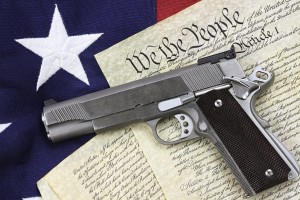Amanda Turner ‘19:
The world has changed dramatically after the horrific shooting in Las Vegas this past month. A white, Christian male of American descent opened fire onto thousands of spectators with high-caliber, military-grade weapons. Already, the notion that terrorism comes from certain ideologies or races is out of question. No matter what color, gender, religion, or ethnicity – terrorism exists and the definite source is not derived from a specific entity.
The second amendment of the Constitution states: “A well regulated Militia, being necessary to the security of a free State, the right of the people to keep and bear Arms, shall not be infringed.” At first sight, it seems that a ‘militia’ has the right to possess guns. However, this amendment was introduced in 1791 with the adoption of the Bill of Rights. In modern society, the Founding Fathers couldn’t have fathomed the idea of atomic bombs, chemical and biological weapons, or rapid-fire ordinance.
The Second Amendment contains restrictions. For instance, one cannot be in control of any weapon of mass destruction, such as nuclear weapons. This restriction seems vague – the fatal capacity of machine guns in present day clearly has the capacity of mass destruction in light of recent mass shootings. In the aftermath of the Las Vegas shooting, 59 people passed away while 527 remain injured. Taking this into consideration along with the other countless incidents with guns that have involved fatalities, the death toll rises dramatically.

Photo courtesy of Gun News Daily
The gun control debate has met great support and opposition alike. With the general demographic of Republicans and Democrats being pro-gun and anti-gun respectively, the political climate has become increasingly hostile, with only more conflict and no true answer to the problems that have persisted in American society for over five decades. Dr. Christopher Row, Upper School religion teacher, said that “The second amendment is a trying part of our constitution, so at one level, opinion is irrelevant. [It] is a part of our constitutional system. The question really is ‘Where do you draw the line for restrictions.’’ Row continued that “The second amendment is not absolute. The question or the debate discussion, which seems unfortunately impossible in this political climate – the discussion we should be having is ‘where is that reasonable line?’ in those restrictions since we already have a line that [prohibits] weapons.”
Before his death, on Fox News in 2012, longest serving Supreme Court Justice, Antonin Scalia, said that there are “undoubtedly” lines that must be drawn concerning the Second Amendment. He went on to explain that future Supreme Court cases will define what these lines are. Concerning weapons, Scalia elaborated that “Some undoubtedly are [permissible] because there were some that were acknowledged at the time.” He continued to say that “My starting point and probably my ending point will be what limitations are within the understood limitations that the society had at the time,” Scalia elaborated that “They had some limitations on the nature of arms that could be borne. So we’ll see what those limitations are as applied to modern weapons.”
Row believes that “The climate today makes it impossible to even begin a discussion – that, I think, is one of the saddest aspects to the situation.” If the gun control and regulation debate is to be reconciled, communication and open discussion between all people are key.